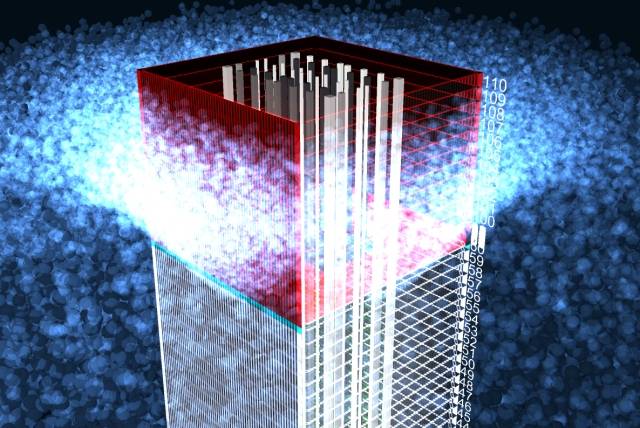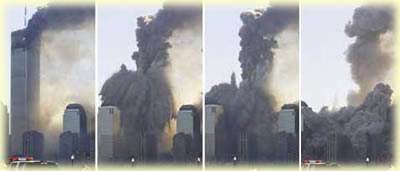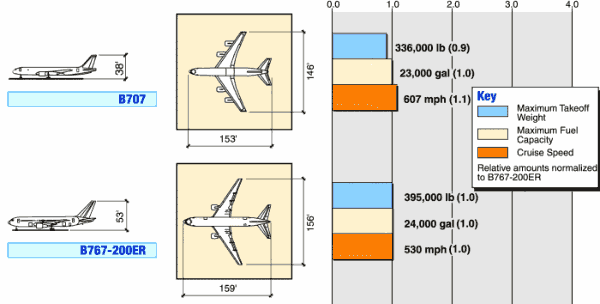Here is some information on the Twin Towers actually being designed to withstand a possible plane impact during foggy conditions....
9-11 Research: Towers' Design Parameters
Contrary to widely promoted misconceptions, the Boeing 767-200s used on 9/11/01 were only slightly larger than 707s and DC 8s, the types of jetliners whose impacts the World Trade Center's designers anticipated
The above graphic from Chapter 1 of FEMA's Report shows the sizes of a 707 and a 767 relative to the footprint of a WTC tower. 1 Flight 11 and Flight 175 were Boeing 767-200s. Although a 767-200 has a slightly wider body than a 707, the two models are very similar in overall size, weight and fuel capacity.
property Boeing 707-320.............Boeing 767-200
fuel capacity 23,000 gallons..........23,980 gallons
max takeoff weight 328,060 lbs.....395,000 lbs
empty weight 137,562 lbs............179,080 lbs
wingspan 145.75 ft.....................156.08 ft
wing area 3010 ft^.....................2 3050 ft^2
length 152.92 ft.........................159.17 ft
cruise speed 607 mph..................530 mph
Given the differences in cruise speeds, a 707 in normal flight would actually have more kinetic energy than a 767, despite the slightly smaller size. Note the similar fuel capacities of both aircraft. The 767s used on September 11th were estimated to be carrying about 10,000 gallons of fuel each at the time of impact, only about 40% of the capacity of a 707.
Statements by Engineers
Engineers who participated in the design of the World Trade Center have stated, since the attack, that the Towers were designed to withstand jetliner collisions. For example, Leslie Robertson, who is featured on many documentaries about the attack, said he "designed it for a (Boeing) 707 to hit it." 2 Statements and documents predating the attack indicate that engineers considered the effects of not only of jetliner impacts, but also of ensuing fires.
John Skilling
John Skilling was the head structural engineer for the World Trade Center. In a 1993 interview, Skilling stated that the Towers were designed to withstand the impact and fires resulting from the collision of a large jetliner such as Boeing 707 or Douglas DC-8.
"Our analysis indicated the biggest problem would be the fact that all the fuel (from the airplane) would dump into the building. There would be a horrendous fire. A lot of people would be killed, ... The building structure would still be there."
A white paper released on February 3, 1964 states that the Towers could have withstood impacts of jetliners travelling 600 mph -- a speed greater than the impact speed of either jetliner used on 9/11/01.
"The buildings have been investigated and found to be safe in an assumed collision with a large jet airliner (Boeing 707DC 8) traveling at 600 miles per hour. Analysis indicates that such collision would result in only local damage which could not cause collapse or substantial damage to the building and would not endanger the lives and safety of occupants not in the immediate area of impact."
The Richard Roth Telegram
On Feburary 13, 1965, real estate baron Lawrence Wien called reporters to his office to charge that the design of the Twin Towers was structurally unsound. Many suspected that his allegation was motivated by a desire to derail the planned World Trade Center skyscrapers to protect the value of his extensive holdings, which included the Empire State Building. In response to the charge, Richard Roth, partner at Emery Roth & Sons, the architectural firm that was designing the Twin Towers, fired back with a three-page telegram containing the following details.
"THE STRUCTURAL ANALYSIS CARRIED OUT BY THE FIRM OF WORTHINGTON, SKILLING, HELLE & JACKSON IS THE MOST COMPLETE AND DETAILED OF ANY EVER MADE FOR ANY BUILDING STRUCTURE. THE PRELIMINARY CALCULATIONS ALONE COVER 1,200 PAGES AND INVOLVE OVER 100 DETAILED DRAWINGS."
" BECAUSE OF ITS CONFIGURATION, WHICH IS ESSENTIALLY THAT OF A STEEL BEAM 209' DEEP, THE TOWERS ARE ACTUALLY FAR LESS DARING STRUCTURALLY THAN A CONVENTIONAL BUILDING SUCH AS THE EMPIRE STATE BUILDING WHERE THE SPINE OR BRACED AREA OF THE BUILDING IS FAR SMALLER IN RELATION TO ITS HEIGHT."
" THE BUILDING AS DESIGNED IS SIXTEEN TIMES STIFFER THAN A CONVENTIONAL STRUCTURE. THE DESIGN CONCEPT IS SO SOUND THAT THE STRUCTURAL ENGINEER HAS BEEN ABLE TO BE ULTRA-CONSERVATIVE IN HIS DESIGN WITHOUT ADVERSELY AFFECTING THE ECONOMICS OF THE STRUCTURE."
At the time the Twin Towers were built, the design approach of moving the support columns to the perimeter and the core, thereby creating large expanses of unobstructed floor space, was relatively new, and unique for a skyscraper. However, that approach is commonplace in contemporary skyscrapers.
Frank Demartini's Statement
Frank A. Demartini, on-site construction manager for the World Trade Center, spoke of the resilience of the towers in an interview recorded on January 25, 2001.
"The building was designed to have a fully loaded 707 crash into it. That was the largest plane at the time. I believe that the building probably could sustain multiple impacts of jetliners because this structure is like the mosquito netting on your screen door -- this intense grid -- and the jet plane is just a pencil puncturing that screen netting. It really does nothing to the screen netting."
Demartini, who had an office on the 88th floor of the North Tower, has been missing since the 9/11/01 attack, having remained in the North Tower to assist in the evacuation. 6 Demartini had first worked at World Trade Center when Leslie E. Robertson Associates hired him to assess damage from the truck bombing in 1993.
Like All Skyscrapers, the Twin Towers Were Over-Engineered
One aspect of engineering that is not widely understood is that structures are over-engineered as a matter of standard practice. Steel structures like bridges and buildings are typically designed to withstand five times anticipated static loads and 3 times anticipated dynamic loads. The anticipated loads are the largest ones expected during the life of the structure, like the worst hurricane or earthquake occurring while the floors are packed with standing-room-only crowds. Given that September 11th was not a windy day, and that there were not throngs of people in the upper floors, the critical load ratio was probably well over 10, meaning that more than nine-tenths of the columns at the same level would have to fail before the weight of the top could have overcome the support capacity of the remaining columns.
There is evidence that the Twin Towers were designed with an even greater measure of reserve strength than typical large buildings. According to the 1964 white paper cited above, a Tower would still be able to withstand a 100-mile-per-hour wind after all the perimeter columns on one face and some of the columns on each adjacent face had been cut. Also, John Skilling is cited by the Engineering News Record for the claim that "live loads on these perimeter columns can be increased more than 2000% before failure occurs."




